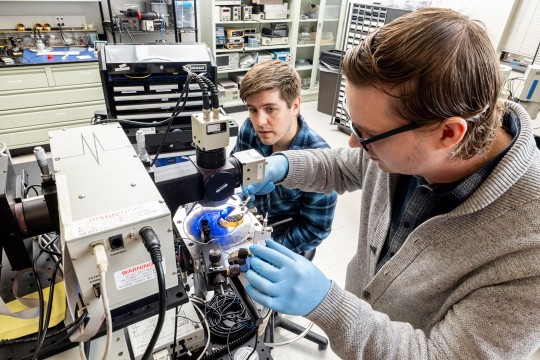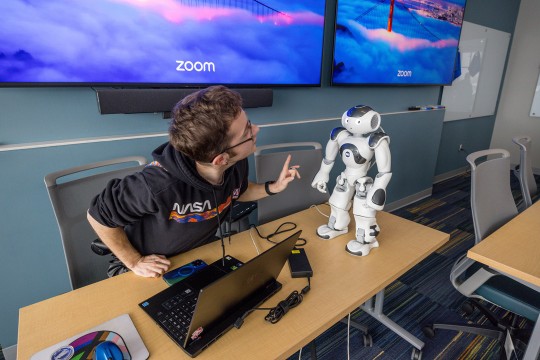RIT and Seneca Park Zoo Society to host Great Lakes Plastic Cleanup event at the Port of Rochester
The event will showcase new plastic pollution cleanup technology
Elizabeth Lamark
An RIT student conducts research using a LittaTrap. The technology will be on display at the Port of Rochester during a Great Lakes Plastic Cleanup at the Port of Rochester on Saturday, April 15.
Rochester Institute of Technology and the Seneca Park Zoo Society will hold a special event at the Port of Rochester from 10 a.m. to noon on Saturday, April 15, to educate members of the public on how they can address plastic pollution and showcase some of the latest technology in the field.
The event is made possible through partnerships with the Great Lakes Plastic Cleanup (GLPC), Monroe County, the City of Rochester, and through funding and support provided by the National Oceanic and Atmospheric Administration’s (NOAA) Marine Debris Program and New York Sea Grant.
The GLPC, a joint effort between the bi-national Council of the Great Lakes Region (CGLR) and Pollution Probe, is the first of its kind using innovative technology to remove plastics and other debris at sites across the region, including in Rochester. The litter collected will be analyzed and categorized, and valuable data will be gleaned to help protect the Great Lakes region, now and for future generations.
Professor Christy Tyler from the Thomas H. Gosnell School of Life Sciences and Associate Professor Matthew Hoffman from the School of Mathematical Sciences secured two NOAA Marine Debris Program awards to investigate plastic waste entering the Great Lakes and develop prevention and removal measures. Tyler said attendees will be able to help clean up litter in the area, see demonstrations of plastic cleanup technology, and get educational materials about plastic pollution.
“We are excited to speak with the public about some of the innovative ways we are studying and cleaning up plastic pollution in our local waterways,” said Tyler. “RIT is becoming a hub for plastic pollution research, and we look forward to showcasing new pieces of technology like Seabins and LittaTraps that are helping us address, analyze, and prevent pollution.”
The Seabin is a trash skimmer designed to be installed in the water of marinas, yacht clubs, and ports. The clean tech unit acts as a floating garbage bin, skimming the surface of the water by pumping water into the device. The Seabin can intercept floating debris, macro and micro plastics, and even microfibers, with an additional filter.
The Enviropod LittaTrap is a patented catch basin basket that sits inside the stormwater drain and prevents litter and other debris carried by stormwater from entering the storm sewer system. The trap’s mesh basket is designed to capture and retain 100 percent of plastic and other debris over 5 millimeters.
“We are very pleased to partner with RIT and the Seneca Park Zoo as part of the Great Lakes Plastic Cleanup,” said Mark Fisher, president and CEO, Council of the Great Lakes Region. “Through this collaboration, we will be able to capture and remove more plastics from local waterways as well as learn more about potential sources and pathways so that we can implement solutions that will forge a future without plastic waste and pollution.”
Tyler, Hoffman, Environmental Education Specialist Kaeti Stoss, Seneca Park Zoo Society naturalists, and RIT students will be on hand to speak with attendees about their research. The Seneca Park Zoo Society will host a clean-up event following the presentation. The event is free and open to the public.








